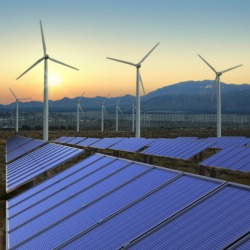 New analysis from Bloomberg New Energy Finance (BNEF) says the levelized cost of electricity (LCOE) for solar photovoltaic (PV) and onshore wind power technologies is approaching parity with gas-fired and coal-fired generation – and is even on par in certain markets.
New analysis from Bloomberg New Energy Finance (BNEF) says the levelized cost of electricity (LCOE) for solar photovoltaic (PV) and onshore wind power technologies is approaching parity with gas-fired and coal-fired generation – and is even on par in certain markets.
LCOE represents the cost of generating a megawatt-hour as a function of the total cost of financing, designing, building, operating and maintaining the plant over its lifetime.
A BNEF report says the global average LCOE for onshore wind has declined slightly during the first half of the year from $85/MWh to $83/MWh in the second half. The global average LCOE for offshore wind – which remains significantly more expensive – fell from $176/MWh to $174/MWh. Over the same period, the global average cost for crystalline silicon PV fell from $129/MWh to $122/MWh.
The drop in cost for these renewable sources accompanies a rise in cost for gas-fired and coal-fired generation in many regional markets. According to the report, the LCOE for combined-cycle gas turbine generation rose from $76/MWh to $82/MWh in the Americas and from $103/MWh to $118/MWh in the Europe, Middle East and Africa region over the course of the year. The cost for coal-fired generation increased from $66/MWh to $75/MWh in the Americas and from $82/MWh to $105/MWh in Europe.
Among the most noteworthy findings in the BNEF report is that onshore wind is now cost-competitive with both gas-fired and coal-fired generation in the U.K. and Germany, once carbon costs are factored in. In the U.K., the LCOE for onshore wind is an average $85/MWh in the second half of the year compared with $115/MWh for combined-cycle gas plants and $115/MWh for coal-fired plants. In Germany, the LCOE for onshore wind is $80/MWh compared with $118/MWh for gas and $106/MWh for coal.
In the U.S., by contrast, coal- and gas-generated power have an average LCOE of $65/MWh compared with onshore wind at $80/MWh and PV at $107/MWh.
Steady improvement
The dynamics of LCOE in various regions are subject to a wide variety of factors, such as utilization rates, fossil fuel extraction techniques, incentives, carbon pricing, and the costs of renewable technologies and project financing. In particular, BNEF's analysis shows that carbon pricing and lower utilization rates are largely responsible for the increase in fossil fuel costs in Europe. The absence of corresponding carbon pricing mechanisms in the U.S. is one reason the LCOE for fossil-fueled plants remains below those of renewables – at least for now.
Jacqueline Lilinshtein, an associate at BNEF specializing in finance and energy economics, says the good news is that the LCOE for renewables in Europe is becoming more attractive, even though incentives such as feed-in tariffs and carve-outs are weakening or fading away entirely.
‘This is the first time in the U.K. and Germany where wind is competitive with gas without any policy or subsidy,’ she says. ‘This means that you are going to see less of a need for them.’
Lilinshtein explains that carbon pricing policies in Europe are not specifically designed to promote the deployment of renewable energy generation. Rather, the pricing is focused on reducing carbon dioxide emissions.
However, it seems that an increase in the price in carbon would have the effect of reducing demand for electricity through higher rates. People are going to use less energy, use it more efficiently or demand electricity from non-carbon sources.
Until carbon pricing works its way into LCOE calculations in the U.S. through the auspices of the Environmental Protection Agency's Clean Power Plan, cap-and-trade systems or carbon taxes, the emphasis is going to remain on cutting costs for renewable generation. Although the golden age of cost reductions may be behind us, Lilinshtein says many opportunities remain to bring down LCOE – for solar, at least.
‘The margins are very thin everywhere – nowhere moreso than in manufacturing,’ Lilinshtein says. ‘But it doesn't have to be necessarily on the manufacturing side. There are opportunities to reduce soft costs, such as installation, project development and permitting costs.’
Although there are no forecasts in the BNEF report, Lilinshtein says, the LCOE for solar power is going to continue to become more attractive. An interesting aspect of the U.S. market is that it is essentially a vast collection of markets with 50 states and thousands of utilities. This makes it difficult to generalize.
‘Solar is probably the biggest thorn in the utilities' sides,’ she says. ‘They realize solar is here now. There are no ifs, ands or buts about it. The question is, how are they going to adapt to it? Some will figure out how to live with solar and profit from it. Others will fight as hard as they can and use any means necessary to stop solar growth.’
On the wind side, BNEF does not anticipate any significant reductions in the cost of onshore wind technologies. However, there are opportunities to increase output, such as through the introduction of taller poles for turbines that enable them to reach higher.
‘You catch more wind higher up,’ Lilinshtein says. ‘That extra output makes the total LCOE go down.’



